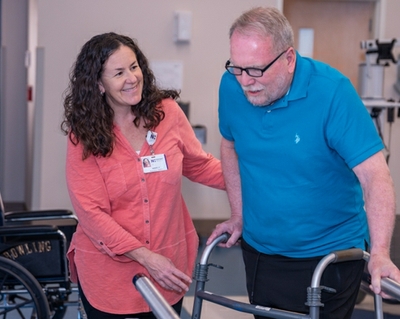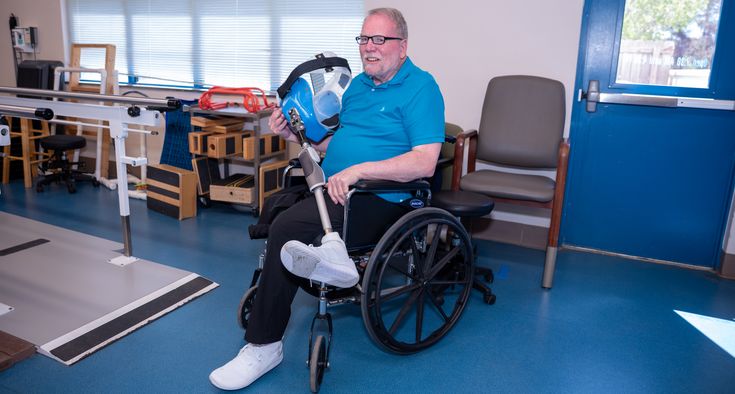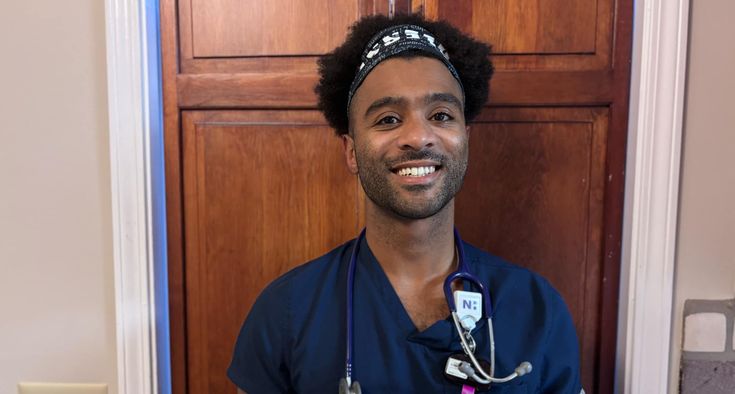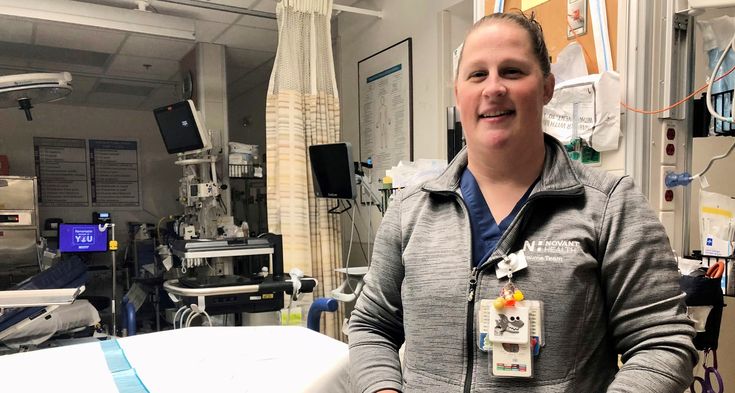A deepened sense of joy. Gratitude for the unshakable love and partnership of his 50-year marriage to his wife, Joie (pronounced Joey). Awe and appreciation for the prayers, support and care of an entire network around him. These are just a few of the things Floyd Hall will tell you he has gained in the last three years. What he doesn’t dwell on is what he lost: his right leg.
The amputation was what’s called a hip disarticulation, meaning the leg – all the way up to the hip joint – was removed in a procedure that accounts for only 0.5% of limb amputations.
Yet Hall – a 71-year-old retired United Methodist minister – was determined to not only survive, but to thrive. That’s what led him to Novant Health’s Rehabilitation Center on Oleander Drive in Wilmington. Adjusting to his new wheelchair was a challenge he was ready for, and he was determined to meet a bigger goal, too.
Hall knew that with the right attitude, plus the right care team and resources, he would one day be able to stand and walk again.
Advanced treatments to help you move more easily.
Making the choice to live
In December 2022, Hall had surgery at a hospital in North Carolina’s Triad region to remove a cancerous tumor in his right leg. While he was recovering at home in Sneads Ferry, near Topsail Island, his femoral artery ruptured. That’s life-threatening; you can bleed out in less than five minutes. Joie called 911 and put pressure on the wound. When the medics arrived, Hall didn’t have a pulse. He arrived back at the Triad-area hospital intubated.
Radiation treatment for cancer had caused extensive damage to Hall’s circulatory and muscular systems. On Christmas Eve, the surgeon cautioned Hall: If a femoral artery burst again – which was likely – he’d die. “If we amputate, you’ll live,” the doctor said. Hall’s leg was amputated on Dec. 27, 2022.
Hall’s surgeon told him he would be in a wheelchair for the immediate future, but he was hopeful Hall would walk again. Hall chose to be hopeful, too.
Finding the right care team
The Halls knew they had a long road ahead of them. Rehabilitation through physical therapy is crucial after an amputation to regain strength and mobility and to help restore independent movement. As an added challenge, Hall is legally blind and needed to learn how to move safely without relying on sight.
The Halls wanted a physical therapist who would match their level of determination. Joie refused to be deterred by the “no’s” she kept getting when she called around. The rarity of Hall’s amputation was such that many had never even heard of it.
This was the case for Debbie Knudsen, supervisor at Wilmington’s Novant Health Rehabilitation Center on Oleander Drive, and an occupational therapist with 26 years of experience. She manages the daily operations of the clinic, which offers physical, occupational and speech therapy for children and adults.

No one at the clinic had ever worked with a patient with such an extreme amputation, but that didn’t stop Knudsen from accepting Hall as a patient.
“I had just the right therapist,” Knudsen said. Amber Ponnett, who’s been in the field for nearly 28 years, eagerly accepted the challenge.
“Amber is the ultimate patient advocate,” Knudsen said. “All our therapists are fantastic, and any of them would’ve done an outstanding job with Floyd. But I knew Amber would do the research. It was truly a labor of love.”
Joie knew right away she had found the right fit. “When I called Debbie, she was an angel just when we needed one,” Joie said. “Floyd was so discouraged, so depressed. He needed a place that would encourage him.”
Beginning again
This March marked two years since Hall and Ponnett’s first therapy session – a time Hall said he felt “helpless.”
But from the beginning, Ponnett gave him hope.
Hall, Joie and Meggie – their 8-year-old cocker spaniel service dog – drive about an hour to Wilmington twice a week for 45-minute physical therapy sessions. They were committed to it for however long it would take. Ponnett didn’t provide a timeline. She just said, “Let's see how much we can accomplish.”
The Halls don’t mind the trek. Although PT is hard work, they enjoy their visits. “The staff cares so much about Joie, too,” Hall said. “They support her every bit as much as they support me. And they always make a fuss over Meggie.”
From the beginning, Ponnett knew Hall would accomplish what he set out to. “Even with his amputation and his visual deficits, I never felt he wouldn’t return to some type of ambulation (standing, walking and maintaining balance),” she said. “We always push for maximum independence.”
Knudsen was confident, too. “Based on our staff and Floyd’s attitude, I absolutely thought he could walk again,” she said. “I see miracles happen here every day – more than anywhere I've ever worked. And I've worked a lot of places. We don’t want our patients just to live. We want them to thrive.”
Building strength and confidence
“When I met Amber,” Hall said, “I could barely do anything.”
He couldn't get out of bed or roll over by himself. Early on, a Hoyer lift was needed to transfer Hall from his wheelchair to another location at the clinic – a scanner, for instance. Now, he does it on his own.
Ponnett worked with Hall on building his core strength with sit-ups and crunches to prepare him for his prosthetic. She had to consider not just Hall’s amputation – but his vision. “Because he can't see his environment, he needs to tap into all his senses to feel stable and secure,” she said.
She made sure her patient was ready when the big day came.
Seven months after starting PT – Hall remembers the exact date: Oct. 19, 2023 – he got his prosthetic leg.
But, the wound site was still inflamed. Then, when the swelling went down, the original prosthesis no longer fit. That’s been the pattern for more than two years. Make one adjustment. Then, discover another is needed.
His prosthetic is an impressive piece of equipment. Knudsen described it as “a giant hip piece that Floyd literally sits in. It goes all the way up to his pelvis. The top of it is a seat – a saddle, almost.”

He’s come far since then.
The Halls planned a trip to Charleston, South Carolina. (Of course, a retired minister would gravitate to “The Holy City.”) Since they wanted to ride in a horse-drawn carriage, Ponnett rigged a golf cart to simulate the carriage and worked with Hall until he was able to get himself in and out.
Hall still uses a rolling walker along with the prosthetic, but he and Ponnett are working toward independent walking, so he’s still coming to PT twice a week. Ponnett wants to get Hall “a little safer on stairs,” while Hall has his own goals.
He hopes to return to Charleston and walk with Joie on the boardwalk along Shem Creek – a spot they both love.
He’d also love to walk with Joie on the beach, but soft sand poses a big challenge. “We’ve done it once,” said Joie, “but it's really difficult. We’ve taken him to the beach in his beach wheelchair and tried to get him to flat sand. It’s hard to get through that fluffy sand at the beginning.”
Ponnett has devised ways for Hall to practice walking on uneven surfaces to get used to the sensation. And they’re working on kneeling, which “starts with trying to figure out where Hall can put his hands to feel secure and stable,” she said.
There’s a specific reason Hall is working on kneeling.
He’s been wheeled into the majestic Duke Chapel many times while in the region for treatments. But one day soon, he intends to walk down its center aisle, kneel and say a prayer of thanksgiving. He has so much to be grateful for, he said.
Hall is humble and was reluctant to be featured in this story. He only agreed to it for two reasons: to give kudos to Ponnett and Knudsen and to encourage others to try PT. “If there's somebody who’s tentative or unconvinced they can do physical therapy, I hope this encourages them,” he said. “These people make miracles happen.”












